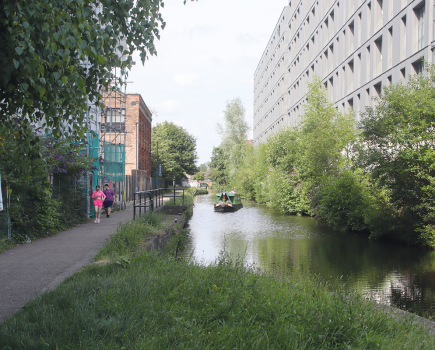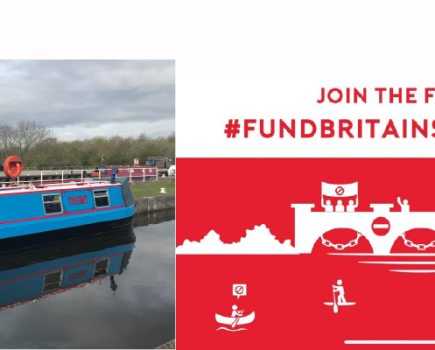Words by Nick Wall. Images by Nick Wall and David Jowett.
‘What great despair confronted me when we explored the adjoining Stroudwater! Infilled, mutilated, truncated and obliterated. And worse still… it was being infilled while I watched! How could anyone have let this happen. I was furious.’
These were the words of Michael Ayland, founder of the Stroudwater Canal Society 40 years ago – and he was right. When I moved to Stroud 12 years ago I walked the length of the Stroudwater Navigation and the Thames & Severn Canal, the old route that linked the Severn to the Thames, because I was fascinated by canals and industrial heritage.
There were old swingbridges that no longer swung, spill weirs that had no need to spill any more and as for Brimscombe Port, a large trans-shipment basin just after the point where the Stroudwater Navigation becomes the Thames & Severn Canal, it was a car park.
If you paused for a moment on a quiet evening you could imagine it being busy, noisy and alive with boats fighting to get in, unload and get out again. But as for ever seeing boats on the canal again? No chance apart, perhaps, from the occasional canoe, on one of the lengths still vaguely in water. The Cotswold Canals Trust (CCT) was doing a good job, but the task of reopening seemed far too great; it would, perhaps, just be just a piece of decaying local heritage that was getting a bit of a wash and brush-up by enthusiasts.
But, of course, restoration is often like that. Nothing much appears to happen for decades (even though it is in the background) then, suddenly, it all starts coming together and before you know it, boats are back on the water – which they were at Stroud at the beginning of June for the first time in 80 years.
This stretch of the canal from Dudbridge to Ocean, at Stonehouse, was officially opened at the Stroud on Water festival, which was also this year’s IWA’s Trailboat Festival. Areas of dry ground where I had walked just a decade ago were now in water; locks were working with water flowing through the dry chambers I had once looked closely at.
All of this was down to two main things – the dedication of volunteers ranging from the CCT and others such as Dig Deep and the Waterways Recovery Group, and a �25 million project (funded with �12 million from the Heritage Lottery Fund, �7.5 million from the South West Regional Development Agency, contributions from other sources and �800,000 from the Trust) led by Stroud District Council.
The newly open section is part of what’s known as Phase 1A. Before too long it will join up with another restored section a little further along at the new Stroud Brewery Bridge, built in the centre of Stroud to take the A46 over the canal and opened by Princess Anne in February, making the ‘open’ length around five miles.
Next to this bridge, Wallbridge Lock has already been restored and the two now make a canal centrepiece in the town. From here work is progressing quickly eastwards towards Brimscombe Port and it’s hoped that this whole six miles or so of Phase 1A will be complete in 18 months to two years’ time.
And that’s where this restoration project gets smart. While having six miles of restored canal open will be nice (it will be a decent four hours-ish cruise each way taking into account all the locks) and good for helping to rejuvenate the Stroud area, it will still be an isolated stretch. Which means the pressure to continue on and relink it to the Gloucester & Sharpness Canal at Saul will be immense, which brings us to what’s dubbed Phase 1B.
As the canal breaks away from the Cotswold hills it simply has to cross the plain towards the Gloucester & Sharpness, which parallels the River Severn. While the canal bed has disappeared in places that’s nothing a JCB or two can’t fix, but it does have three main barriers, the A38, the M5 and the railway mainline, all of which run northwards from Bristol to the Midlands, cutting across the canal’s line.
The A38 shouldn’t be a major problem (“we’ll just plough straight through the roundabout – easy job”, said someone who should know), the M5 already has a culvert for the River Frome a windlass throw from the line of the original canal so that’s a simple detour, then there’s the railway. This will be trickier and expensive because, much as one might like to, you can’t just stop the trains to build a canal bridge underneath.
Much of this work will have to be done by professional companies. An initial approach to the Heritage Lottery fund for �13.6 million to complete the link was rejected in May, but there are many who believe the application was simply made a little too early and once further finishing work has been done on Phase 1A, a fresh application funding for the link to Saul will follow.
But that’s not the end, far from it. While this frenzy of activity has been going on around Stroud, the Trust has been working on securing land along the Thames & Severn Canal at the eastern end of the project, called Phase 2, with a view to eventually relinking to the Thames at Inglesham.
Volunteers have been working at numerous locations within the Cotswold Water Park section and elsewhere along this length, quietly getting on with sorting out some of the structures, locks and lengths of canal. How long will it take to be ready for boats? No-one really wants to give a definitive answer or set deadlines, but take a walk along its towpath and, thanks to the work already done, it already looks like a fully fledged canal in places. Judging by the speed with which Stroud is now coming together, a good length of it could be open by the end of the decade.
All this jumping from west to east on the canal might sound odd and there’s a reason for that – the Sapperton tunnel. It’s not quite slap bang in the middle of all this, but not far off. At 2.17 miles it’s one of the longest tunnels in the country and roof falls have blocked the middle and Daneway (west) end. Despite this, a recent survey showed that while repairing it will be a big job, it might not be as bad as was once feared.
Several hundred yards require a total rebuild, but this is likely to be a fair way off until Phase 2, from the Thames to the Cotswold Water Park, is finished and the tunnel, part of Phase 3, may well be the very last link in the chain.
Earlier engineering studies proposed replacing large parts of it with a modern concrete segment lining (as was done with the centre sections of Blisworth and Preston Brook tunnels in the 1980s). However, the feeling now is that, if it were possible to retain and stabilise what survives of the original by inserting a concrete base to eliminate problems of leakage, the end product would be a more fitting tribute to the 18th century engineers who built it – as well as a more interesting trip.
The other part of Phase 3, which will finally open up the complete 36-mile restoration from the Severn to the Thames, will be the highly sensitive area from the western Daneway portal down through the Sapperton valley to Brimscombe.
Right now it’s a relatively steep hillside with the bones of 11 tightly-packed locks resting quietly in a beautiful piece of woodland that is also a nature reserve. This will be a major piece of restoration which, because of its sensitivity, will only be started once much of the rest of the restoration has been completed so that people can see that the work would be handled with great sensitivity for the flora and fauna.
So, three miles open of a potential 36-mile route; why the fuss, you might say? Well, those three will soon become six and those six will become ten and then the Stroudwater will be open to the network offering a very attractive new cruise. And after that, with hard work, dedication, money and a little luck, there will be a new route through to the Thames – these three miles are just the start. Michael Ayland must be very pleased.







